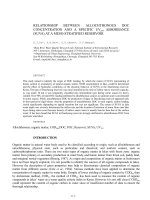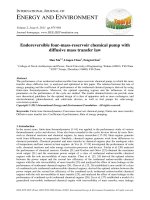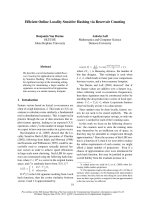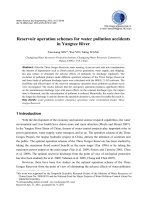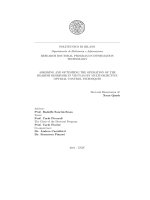RESERVOIR POROSITY
Bạn đang xem bản rút gọn của tài liệu. Xem và tải ngay bản đầy đủ của tài liệu tại đây (2.45 MB, 74 trang )
POROSITY
Many slides contain more detailed notes that may be shown using the “Notes Page View”
Acknowledgments
• Dr. Walt Ayers, PETE 311, Fall 2001
• NExT PERF Short Course Notes, 1999
– Note that many of the NExT slides appears to have been
obtained from other primary sources that are not cited
RESERVOIR POROSITY
Definition: Porosity is the fraction of a rock that
is occupied by voids (pores).
Discussion Topics
• Origins and descriptions
• Factors that effect porosity
• Methods of determination
ROCK MATRIX AND PORE SPACE
Rock matrix
Pore space
Note different use of “matrix”
by geologists and engineers
POROSITY DEFINITION
Porosity: The fraction of a rock that is
occupied by pores
• Porosity is an intensive property describing the
fluid storage capacity of rock
Vp
Vb − Vma
Porosity = φ =
=
Vb
Vb
ROCK MATRIX AND PORE SPACE
Rock matrix
Water
Oil and/or gas
OBJECTIVES
To provide an understanding of
• The concepts of rock matrix and porosity
• The difference between original (primary) and
induced (secondary) porosity
• The difference between total and effective
porosity
• Laboratory methods of porosity determination
• Determination of porosity from well logs
CLASSIFICATION OF ROCKS
Rock-forming Source of
process
material
IGNEOUS
SEDIMENTARY
METAMORPHIC
Molten materials in
deep crust and
upper mantle
Weathering and
erosion of rocks
exposed at surface
Rocks under high
temperatures
and pressures in
deep crust
Crystallization
(Solidification of melt)
Sedimentation, burial
and lithification
Recrystallization due to
heat, pressure, or
chemically active fluids
SEDIMENTARY ROCKS
• Clastics
•Carbonates
•Evaporites
CLASTIC AND CARBONATE ROCKS
Clastic Rocks
Consist Primarily of Silicate Minerals
Are Classified on the Basis of:
- Grain Size
- Mineral Composition
Carbonate Rocks
Consist Primarily of Carbonate Minerals
(i.e. Minerals With a CO3-2 Anion Group)
Limestone - Predominately Calcite (Calcium
Carbonate, CaCO3)
Dolomite - Predominately Dolostone (Calcium
Magnesium Carbonate, CaMg(CO3)2 )
SEDIMENTARY ROCK TYPES,
Relative Abundances
Sandstone
and conglomerate
(clastic)
~11%
Siltstone
and shale
(clastic)
~75%
Limestone and
dolomite
~14%
Comparison of Compositions of Clastic
and Carbonate Rocks
Clastic Rocks
Sand
Grains
Carbonate Rocks
Fossils
Allochemical Pelloids
Oolites
Grains
Intractlasts
Quartz
Feldspar
Rock Fragments
Average
Sandstone
Average
Mudrock
(Shale)
Average
Sparry
Limestone
Average
Micritic
Limestone
Clay
Matrix
Chemical
Cement
Illite
Kaolinite
Smectite
Quartz
Calcite
Hematite
Microcrystalline
Matrix
Chemical
Cement
Calcite
Calcite
Grain-Size Classification for Clastic Sediments
Name
Boulder
Cobble
Pebble
Granule
Very Coarse Sand
Coarse Sand
Medium Sand
Fine Sand
Very Fine Sand
Coarse Silt
Medium Silt
Fine Silt
Very Fine Silt
Clay
Millimeters
Micrometers
4,096
256
64
4
2
1
0.5
0.25
0.125
0.062
0.031
0.016
0.008
0.004
500
250
125
62
31
16
8
4
(modified from Blatt, 1982)
Average Detrital Mineral Composition
of Shale and Sandstone
Mineral Composition
Shale
Sandstone
Clay Minerals
60 (%)
Quartz
30
65
4
10-15
<5
15
3
<1
<3
<1
Feldspar
Rock Fragments
Carbonate
Organic Matter,
Hematite, and
Other Minerals
5 (%)
(modified from Blatt, 1982)
SANDSTONE CLASSIFICATION
Quartz + Chert
5
5
Quartzarenite
Subarkose
Sublitharenite
25
25
Lithic
Subarkose
50
50
Ar
ko
se
ren
ha
Lit
Feldspar
10
Lithic
Arkose
25
(modified from McBride, 1963)
Felspathic
Litharenite
50
25
i te
25
25
10
Unstable
Rock
Fragments
FOUR MAJOR COMPONENTS OF
SANDSTONE
Framework
Sand (and Silt) Size Detrital Grains
Matrix
Silt and Clay Size Detrital Material
Cement
Material Precipitated Post-Depositionally,
During Burial. Cements Fill Pores and
Replace Framework Grains
Pores
Voids Among the Above Components
FOUR COMPONENTS OF SANDSTONE
Geologist’s Classification
1.
2.
3.
4.
Framework
Matrix
Cement
Pores
Note different use of “matrix”
by geologists and engineers
Engineering
“matrix”
PORE
FRAMEWORK
CEMENT
(QUARTZ)
MATRIX
FRAMEWORK
(FELDSPAR)
0.25 mm
ORIGINS OF POROSITY IN
CLASTICS AND CARBONATES
(Genetic Classification)
• Primary (original)
• Secondary (induced)
(Generally more complex than
primary porosity)
PRIMARY (ORIGINAL) POROSITY
• Developed at deposition
• Typified by
– Intergranular pores of clastics or
carbonates
– Intercrystalline and fenestral pores of carbonates
• Usually more uniform than induced porosity
SECONDARY (INDUCED) POROSITY
•
Developed by geologic processes after
deposition (diagenetic processes)
•
Examples
–
–
–
Grain dissolution in sandstones or carbonates
Vugs and solution cavities in carbonates
Fracture development in some sandstones, shales,
and carbonates
SANDSTONES POROSITY TYPES
Intergranular (Primary) Interstitial Void Space Between
Framework Grains
Micropores
Small Pores Mainly Between Detrital
Framework Grains or Cement
Dissolution
Partial or Complete Dissolution of
or Authigenic Grains (Can Also Occur
Within Grains
Fractures
Breakage Due to Earth Stresses
FACTORS THAT AFFECT POROSITY
PRIMARY
• Particle sphericity and angularity
• Packing
• Sorting (variable grain sizes)
SECONDARY (diagenetic)
• Cementing materials
• Overburden stress (compaction)
• Vugs, dissolution, and fractures
SPHERICITY
Porosity
ROUNDNESS AND SPHERICITY
OF CLASTIC GRAINS
High
Low
Very
Angular
Angular
SubSubWellRounded
Rounded
Angular Rounded
ROUNDNESS
Porosity
FACTORS THAT AFFECT POROSITY
PRIMARY
• Particle sphericity and angularity
• Packing
• Sorting (variable grain sizes)
SECONDARY (DIAGENETIC)
• Cementing materials
• Overburden stress (compaction)
• Vugs, dissolution, and fractures
GRAIN PACKING IN SANDSTONE
Line of Traverse
(using microscope)
4 Types of Grain Contacts
Packing Proximity
Sutured Contact
A measure of the extent to
which sedimentary particles
are in contact with their
neighbors
Long Contact
Packing Density
Tangential Contact
Cement
Matrix
(clays, etc.)
A measure of the extent to
which sedimentary particles
occupy the rock volume
Concavo-Convex
Contact
This Example
Packing Proximity = 40%
Packing Density = 0.8
(modified from Blatt, 1982)
